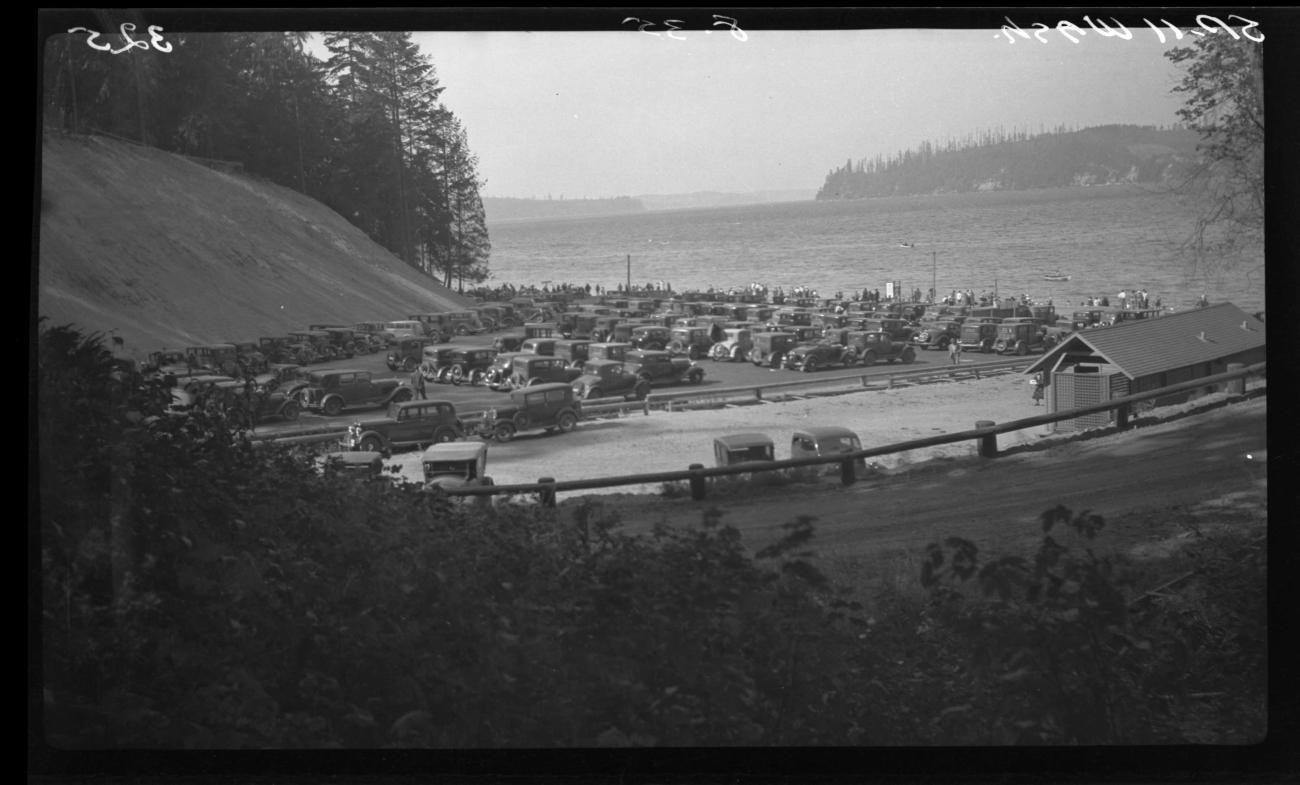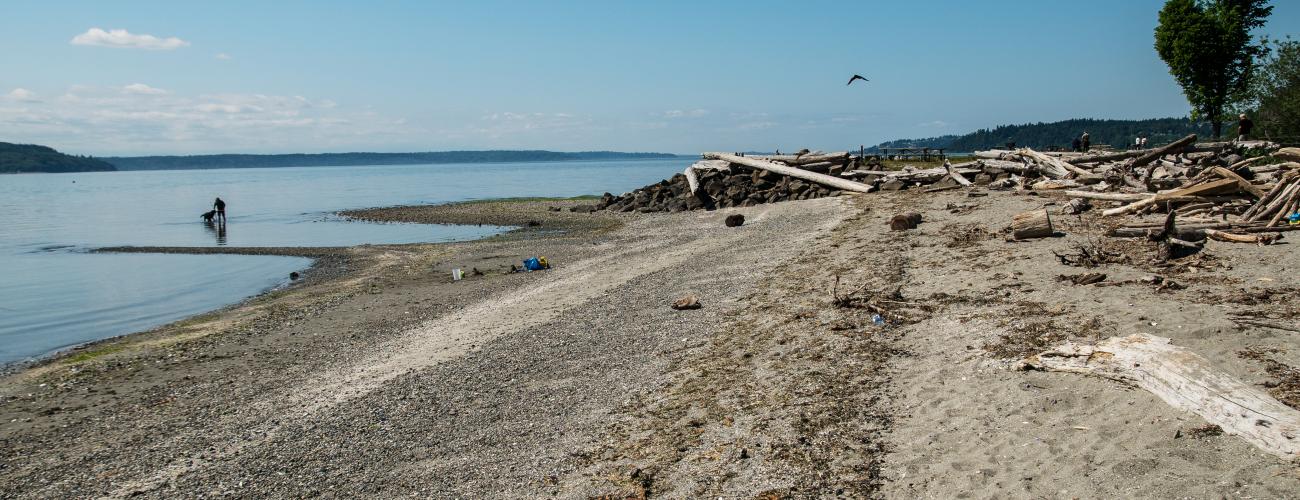Saltwater State Park History
Saltwater State Park provides access to the shores and undersea gardens of Puget Sound in the midst of one of the largest metropolitan areas in the United States. The woodsy ravine behind the beach can be explored on miles of trails, and visitors enjoy camp life just minutes from the homes of millions of people.
Indigenous Lands
Saltwater State Park lies within the traditional territories of Coast Salish Indigenous people whose present-day descendants include members of the Muckleshoot Indian Tribe and Puyallup Tribe. For thousands of years the shoreline and wooded ravine have provided habitat for a diverse community of life that forms the basis of their cultures. Muckleshoot elder Louis “Doc” Starr, born in 1898, recounted stories of trips down an ancient trail through the McSorley Creek ravine to gather “horse clams, cockles, all kinds….there was no limit to their digging. There was all the clams they wanted.”
Settler Homestead
Local tribes ceded ownership of the area to the US federal government in the Treaty of Medicine Creek in 1854, keeping rights to harvest natural resources in their usual and accustomed places, including the beaches and waters of East Passage. After government land surveys were completed, the land passed into private ownership with a Homestead Patent to James McSorley on April 25, 1877. McSorley was an immigrant from Ireland, who had moved with his wife, three sons and two daughters to take advantage of the opportunity to claim title to these 170 acres of land. The family built a home and planted fruit trees. Work in logging and carpentry augmented the subsistence provided by the marginal farm. In 1882, Mrs. McSorley and an infant son died, likely from a smallpox or influenza epidemic. In 1902, McSorley sold the land to King County to cover back taxes.
A Tale of Two Cities
In the 1920s, people suggested that a waterfront park should be built between Seattle and Tacoma in order to establish a truce in their competition to become the most important city on Puget Sound. The rivalry embroiled the two cities in a debate over the name of Washington’s highest mountain, named by Captain George Vancouver for British Rear Admiral Peter Rainier. Tacoma citizens had unsuccessfully endorsed a bill in the US Congress in 1924 to name the mountain “Tahoma,” an anglicization of the Indigenous Lushootseed language word “təqʷubəʔ,” often used to refer to the mountain. Seattle had opposed the bill.
The Young Men’s Business Clubs of Tacoma and Seattle began a campaign to raise $18,000 to purchase a portion of the original McSorley homestead. 6,000 individuals answered their call to donate to the project, most giving $1. King County Commissioner Frank H. Paul contacted the Washington State Parks Committee to propose that the land be managed as a state park. The committee did not have sufficient funds to purchase the land, but agreed to cooperatively manage the park until the transfer could be completed.
The park was dedicated on April 24, 1926. Governor Roland H. Hartley attended, along with Tacoma Mayor Angelo V. Fawcett, Seattle Mayor Edwin J. Brown and Seattle Mayor-elect Bertha Landes, the first female mayor of a major American city. A crowd of 5,000 people came to the event, which featured the mayors ceremonially “burying the hatchet” under a newly planted hawthorn tree to end the contention between their cities.
Second Dedication
On February 17, 1929, the State Parks Committee purchased the park from King County for $10,021.61. Unfortunately, due to Governor Hartley’s veto of state park funding, they were unable to provide additional recreational development. After funding was restored, another park dedication was held on August 20, 1933. 15,000 people attended, and another 5,000 were turned away because there was no parking space left within a mile radius. Speeches were delivered by Governor Clarence D. Martin and the mayors of Tacoma and Seattle. A squadron of planes from Sand Point Naval Air Station performed stunt flying. Miss Diana Jewett of Renton was named the winner of the “park’s first beauty contest.” After the dedication, she presided over a ball at the nearby Spanish Castle Ballroom.
Civilian Conservation Corps
In the 1930s as the Great Depression deepened, people throughout Washington and across the US struggled with poverty as job losses and business closures erased their economic security. Newly elected President Franklin D. Roosevelt moved fast to provide material relief for suffering families, and one of the earliest hallmark programs of the administration was the Civilian Conservation Corps (CCC). Intended to provide useful employment and training for single men aged 18 to 25, the CCC ultimately provided jobs for more than 2 million enrollees who performed work in national and state parks and forests at more than 500 camps.
CCC Company 935 moved to Saltwater State Park on May 10, 1934. The crew widened and graded the park’s access road, built restrooms and caretaker’s residence. Their largest project was the construction of a 1,300-foot backfilled seawall that served as a promenade above the beach. The CCC workers also assisted with the development of nearby Point Defiance Park in Tacoma. No permanent camp facility was built for overwintering, so Company 935 moved on in November 1934, building trails and other facilities in Ginkgo Petrified Forest State Park in eastern Washington.
Over time, wave action damaged the sea wall, and a new shore armor structure was built and dedicated on July 27, 1952.

Underwater Park
On April 20, 1970, The Washington State Parks and Recreation Commission (WSPRC) designated an area of the seabed extending ¼ mile from the beach in Saltwater State Park as one of six underwater parks, to protect underwater resources and provide a quality scuba diving location. A buoy marks the site of a sunken wreck about 300 yards from shore, where divers can find wolf eels, plumose anemones, large rockfish, lingcod and Giant pacific octopus.
Sharing the histories of Washington’s state parks is an ongoing project. Learn more here.

